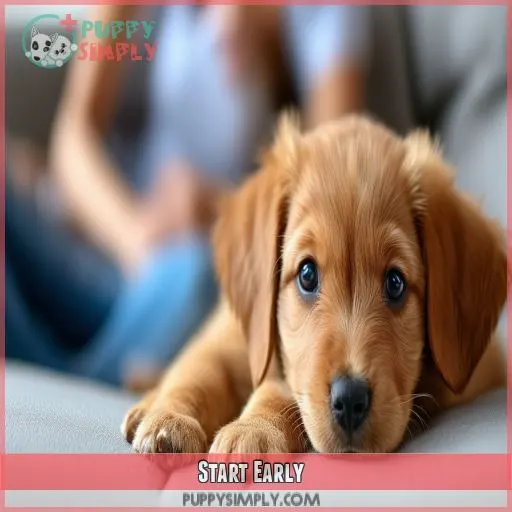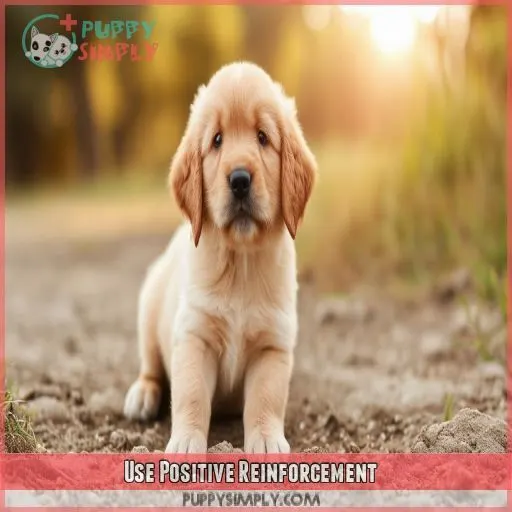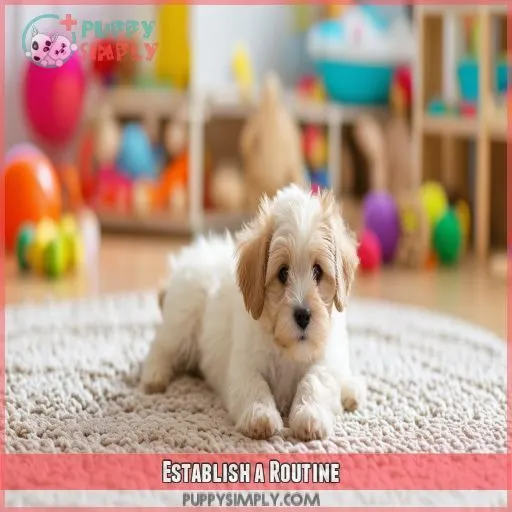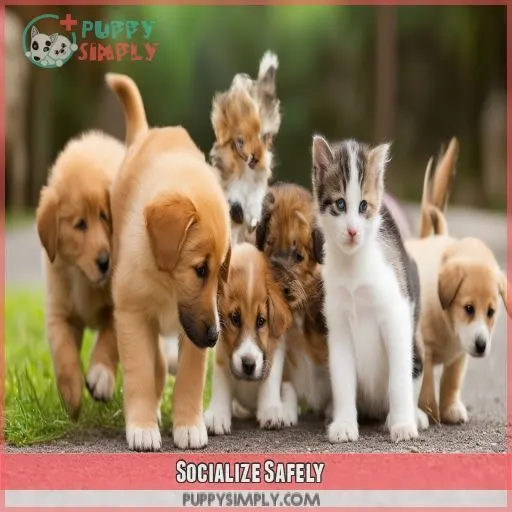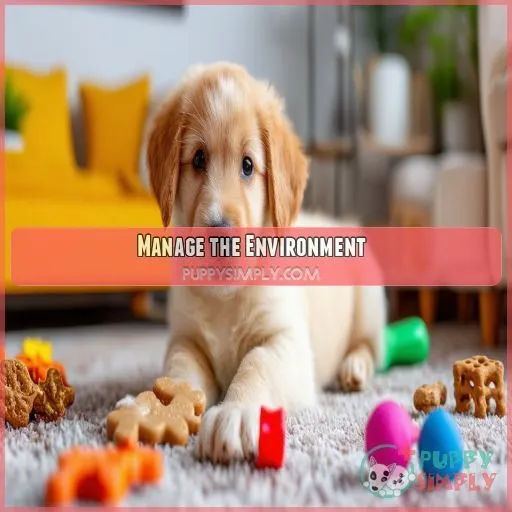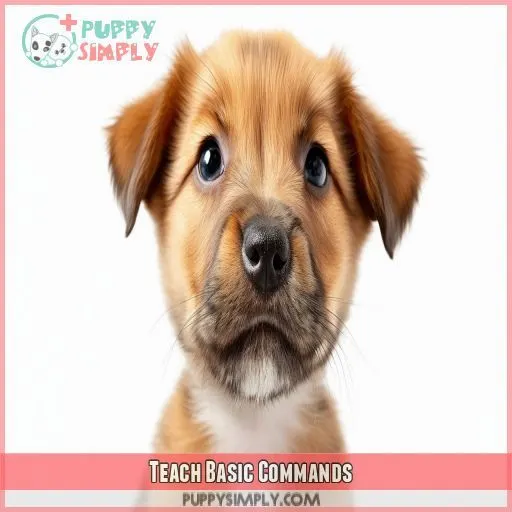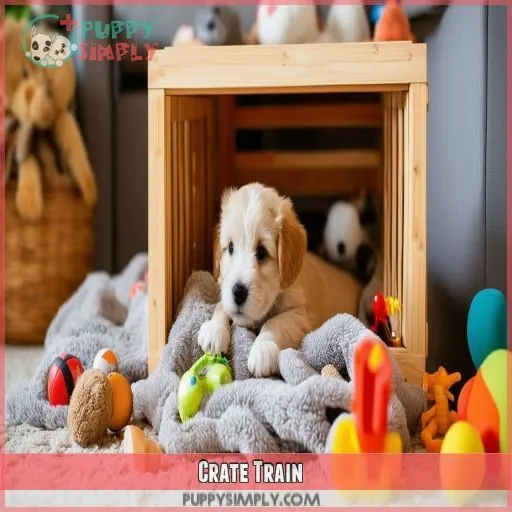This site is supported by our readers. We may earn a commission, at no cost to you, if you purchase through links.
 Puppy training can be exciting and overwhelming if you are new to the process. Before you get started, there are some key things to remember when it comes to success: critical socialization period, positive reinforcement, and daily routine.
Puppy training can be exciting and overwhelming if you are new to the process. Before you get started, there are some key things to remember when it comes to success: critical socialization period, positive reinforcement, and daily routine.
You must manage your environment correctly, teach basic obedience commands, and finesse crate training.
Let these expert tips on these critical elements guide you through raising your excellent companion.
With patience and consistency, you will develop a solid base for your puppy’s lifelong learning and development
Table Of Contents
- Key Takeaways
- Start Early
- Use Positive Reinforcement
- Establish a Routine
- Socialize Safely
- Manage the Environment
- Teach Basic Commands
- Crate Train
- Be Patient and Consistent
- Seek Professional Help if Needed
- Make Training Fun
- Frequently Asked Questions (FAQs)
- What is the first thing you should train your puppy?
- What is the best age to start puppy training classes?
- When should a puppy know basic commands?
- What is the first command to teach a puppy?
- Is it easy to train a puppy?
- What do you need to know about puppy training?
- How do you train a puppy to say ‘please’?
- When should you start teaching a puppy?
- How long should each training session last?
- Can I train my puppy before vaccinations?
- Should I use treats or toys for rewards?
- When is the best time of day to train?
- How do I stop my puppy from chewing furniture?
- Conclusion
Key Takeaways
- Start early and make the most of that critical 3-12 week puppy brain sponge time. Your furry friend’s mind is like a blank canvas just waiting for you to paint some good habits on it!
- Positive reinforcement is your secret weapon. Treats, praise, and play are your puppy’s love languages – use them liberally and watch that tail wag with joy.
- Consistency is king (or should we say, top dog?). From potty breaks to training sessions, a predictable routine will have your pup feeling secure and ready to learn.
- Keep it short and sweet, like a puppy’s attention span. Aim for quick, fun training bursts throughout the day – Rome wasn’t built in a day, and neither is a well-behaved pup!
Start Early
You’ll want to start training your puppy as early as possible, ideally during their critical socialization period from 3 to 12 weeks old. This early start helps build a strong foundation for your puppy’s future behavior and makes it easier for them to learn and adapt to new experiences
Puppies Have a Critical Socialization Period From 3-12 Weeks
Your puppy’s critical socialization period, from 3 to 12 weeks, is a golden opportunity. During this time, their brain’s like a sponge, soaking up experiences that shape their future behavior.
Expose them to various sights, sounds, and textures. Introduce gentle human touch, car rides, and brief separations.
This early socialization builds trust, prevents anxiety, and lays the foundation for a well-adjusted adult dog
Early Training Helps Build a Strong Foundation
You’ll set your puppy up for success by starting training early. Puppies’ brains are like sponges, absorbing information rapidly.
Consider your pup’s age, breed, and individual differences when planning training sessions. Use positive, fear-free methods and pain-free handling to create a conditioned emotional response to learning.
Tailor your approach to environmental influences and choose appropriate training tools. Focus on rewards and motivation to build a strong recall and other essential skills
Use Positive Reinforcement
When training your puppy, use positive reinforcement techniques to create an effective and enjoyable learning experience. Reward good behavior with treats, praise, and play, while avoiding punishment that can damage the bond and trust between you and your puppy
Reward-based Training is Effective and Enjoyable for Puppies
Reward-based training is a game-changer for puppy education. It’s not just effective; it’s a tail-wagging good time for your furry friend. Here’s why it works:
- Taps into your pup’s natural desire to please
- Creates positive associations with learning
- Boosts confidence and reduces stress
- Strengthens your bond through fun interactions
Use Treats, Praise, and Play to Reinforce Good Behavior
Building on the foundation of reward-based training, find how these simple tools—tasty treats, praise, and play—are potent tools to reinforce good behavior. Here’s a quick guide on how to maximize your puppy’s training success:
| Reinforcement | Timing | Effectiveness |
|---|---|---|
| Treats | Immediate | High |
| Praise | During/After | Moderate |
| Play | After | High |
| Toys | During | Moderate |
| Petting | During/After | Variable |
Mix these rewards to keep your pup interested and motivated. Timing is everything, so make sure to quickly reward to connect the action with the positive result.
Avoid Punishment, Which Can Damage the Bond and Trust
When housebreaking your puppy, avoid punishment at all costs. It isn’t only ineffective but can effectively ruin the relationship you’re trying to develop. Instead, focus on positive reinforcement techniques meant to help you shape your pup’s behavior. Reward-based training establishes a trusting relationship and arouses your furry friend’s desire to learn eagerly.
Here are some alternatives to punishment that build trust:
• Redirect unwanted behavior with treats and praise
- Provide appropriate chew toys to avoid destructive chewing
Implement time-outs for overexcitement, not as a punishment.
Establish a Routine
Establish a routine when training your puppy; it provides the necessary structure and predictability for him to grow. Be patient and consistent in your training, as through this, your puppy will understand what’s expected of him quickly, thus developing good habits.
Puppies Thrive on Consistency and Predictability
Puppies crave structure, so establishing a consistent routine is key to successful training. Set regular times for meals, potty breaks, exercise, and command practice.
Incorporate crate training and socialization into your daily schedule. A predictable routine helps with housetraining and reduces anxiety.
Consistency in your puppy training commands and positive reinforcement techniques will accelerate learning and strengthen your bond
Be Patient and Consistent With Your Training Methods
Consistency is key in puppy training. To reinforce good habits, follow these steps:
- Set a fixed training schedule
- Use the same commands and hand signals
- Maintain a consistent reward system
Socialize Safely
Now that you have established some routine let’s focus on safe socialization. Puppies are in a critical window of socialization from 3-12 weeks. It’s essential to expose your puppy to new things during this time frame. Follow these tips to enable your puppy best to grow into an emotionally healthy adult dog:
- Gradually expose your puppy to new people, animals, and environments.
- Supervise puppy interactions to avoid nasty experiences.
- Reward with treats and praise to confirm good associations of new situations.
- Be patient and allow your puppy to explore at their own pace.
Provide safe situations for socialization, such as puppy classes or playdates with vaccinated dogs. Expose him to sights, sounds, and textures in appropriate situations. It’s the quality of interaction that matters, not the quantity. Be sure to supervise play and create positive experiences within those windows of socialization to help your pup gain confidence and develop those critical social skills.
Manage the Environment
When socializing a puppy, there’s one more critical point to be kept in mind: keeping his environment under control. That’s how you’ll ensure that your furry friend will be safe while studying the world. Build up a puppy-proof zone where exploration can occur without hazards. Take out risks like poisonous plants, small objects, electrical cords, etc. Following is a fast lead on how to cope with different areas:
| Area | What to Remove | What to Add |
|---|---|---|
| Living Room | Fragile items, cords | Chew toys, puppy bed |
| Kitchen | Waste bins, cleaning supplies | Water bowl, safe treats |
| Bedroom | Shoes, small accessories | Crate, comfy blanket |
| Bathroom | Toiletries, medications | Non-slip mat |
| Outdoor Area | Toxic plants, sharp tools | Fencing, shaded area |
Teach Basic Commands
Start your puppy’s training with basic commands like "sit," "stay," and "come," which form the foundation for more advanced skills. Keep training sessions short and frequent, offering plenty of rewards to reinforce good behavior and maintain your puppy’s interest and motivation
Start With Simple Commands Like Sit, Stay, and Come
Now that you’ve managed your puppy’s environment, it’s time to start with basic commands. Begin with "sit," "stay," and "come." Use clear hand gestures and verbal cues to communicate.
Clicker training can be an effective tool, paired with high-value treats. As your pup progresses, introduce distractions to reinforce these commands
Practice in Short, Frequent Sessions With Lots of Rewards
When training your puppy, keep sessions short and sweet. Aim for 5-10 minutes, several times a day. Reward frequently to maintain enthusiasm and reinforce learning.
Start in a quiet environment with minimal distractions, gradually increasing challenge as your pup improves.
Repeat commands consistently, but mix up the order to keep things interesting
Crate Train
Crate training is an essential tool for housebreaking your puppy and preventing destructive behavior when you’re away. Introduce the crate gradually as a positive, safe space for your puppy, and never use it as punishment to maintain its effectiveness as a training aid
Crate Training Helps With Housetraining and Prevents Destructive Behavior
After the basic commands are learned, crate training is the next major step. A crate has several advantages:
• Helps in housetraining by working with a dog’s denning instinct
• Prevents destructive behavior when you’re away
• Provides a safe-space for your puppy to relax.
Size: Be careful about the size of the crate. It should be big enough for your puppy to stand up and turn around without straining his body, and he absolutely must have room to lie down comfortably without straining or stressing his body. Crate anxiety can result from this situation. In such cases, you might want to consider other options, like playpen setups or even a safe room.
Introduce the Crate Positively and Gradually
To introduce the crate positively, start by placing it in a central area of your home. Choose comfortable bedding and leave the door open, inviting exploration.
Consider the crate’s size – it should be big enough for your puppy to stand and turn around. Add comfort accessories like toys or blankets.
Gradually increase crate time, always associating it with positive experiences
Never Use the Crate as Punishment
Never use the crate for the punishment of your puppy. This can only create negative associations with the crate and defeat the purpose of creating a haven.
Instead, think about alternatives to crates during times when your puppy needs to be corrected. The effects of punishment can last a lifetime, so positive reinforcement is the way forward.
Ensure the correct crate size and place it in an inviting position. Remember, the crate should be your pup’s happy place—it’s not a space used for punishment
Be Patient and Consistent
Now that you have learned how to crate your pup, it’s time to focus on the cornerstones of successful training: patience and consistency. Rome wasn’t built in a day, nor was a well-behaved puppy. Here’s why these traits are crucial:
- Routines create comfort—Keep regularity in feeding, potty, and training times.
- Repetition enforces learning—practice commands in various situations daily.
- Rewards build positive associations: Rewards for good behavior should be consistent.
- Environment affects development: Ensure a calm, organized home environment
Seek Professional Help if Needed
While most puppy training challenges can be dealt with independently, there’s no shame in seeking professional help when needed. State-certified dog trainers can help you with any troublesome puppy issue, behavioral problem, or training difficulty you may face. They check out your home environment and draw up customized strategies to succeed. Here’s a quick guide that might allow you to decide when it’s time to call the experts:
| Situation | DIY Approach | Professional Guidance |
|---|---|---|
| Basic commands | Try first | If no progress in 2 weeks |
| Housetraining | Try | If he still has accidents |
| Socialization | Gradually expose | If fearful or aggressive behaviour develops |
Make Training Fun
Keep your puppy’s training sessions short, frequent, and engaging to maintain their interest and maximize learning. Use their favorite toys and treats as rewards to make training a fun and positive experience, reinforcing good behavior and strengthening your bond
Keep Training Sessions Short, Frequent, and Engaging
While professional guidance may be invaluable, you can make training fun and effective at home. Keep the sessions short and sweet to match your puppy’s attention span. Frequent, engaging practice is the key to success. Here’s how to make any training session fun:
- Aim for 5-10 minute sessions
- Train multiple times a day
- Blend commands with play
- End on a high note
Time management and consistency are critical in staying engaged and earning rewards.
Use Your Puppy’s Favorite Toys and Treats as Rewards
To keep your puppy excited about training, use their favorite toys and treats as rewards. Mix it up with a variety of goodies to maintain interest.
Pay attention to your pup’s treat preferences and use them strategically.
Frequently Asked Questions (FAQs)
What is the first thing you should train your puppy?
Like laying the foundation of a house, start by teaching your puppy their name. You’ll want to create positive associations, using treats and praise when they respond. This forms the basis for all future training commands
What is the best age to start puppy training classes?
You can start puppy training classes as early as 8 weeks old. It’s best to enroll your pup between 8-16 weeks, during their critical socialization period. Early training builds a strong foundation for future learning and behavior
When should a puppy know basic commands?
You’ll be amazed how quickly puppies learn! By 8-16 weeks, they should grasp basic commands like "sit" and "come." Continue training throughout their first year, focusing on consistency and positive reinforcement for best results
What is the first command to teach a puppy?
Start with "sit." It’s simple, practical, and builds a foundation for other commands. You’ll use it often, and it helps your puppy learn to focus on you. Practice in short, fun sessions throughout the day
Is it easy to train a puppy?
Training a puppy isn’t always easy, but it’s rewarding. You’ll face challenges, but with patience and consistency, you’ll see progress. Remember, every pup learns differently. Stay positive, use rewards, and celebrate small victories along the way
What do you need to know about puppy training?
Like a sculptor molding clay, you’ll shape your puppy’s behavior. You’ll need patience, consistency, and positive reinforcement. Start with basic commands, socialize early, and establish routines. Remember, every interaction is a training opportunity. Embrace the journey of growth together
How do you train a puppy to say ‘please’?
Teach your puppy to sit before receiving rewards. Use a consistent cue like "please" when they sit. Reward this behavior with treats, praise, or attention. Soon, they’ll associate sitting politely with getting what they want
When should you start teaching a puppy?
Imagine this: a small ball of fluff, eyes barely open. You’re already behind! The earlier you start training your puppy, the better. In fact, from day one, you’ll be creating habits, rituals, and relationships. Early intervention avoids problems later and achieves the most efficient learning.
How long should each training session last?
Keep your training sessions with your puppy short and sweet; you want to aim for 5 to 10 minutes several times a day. Do this, and you won’t overwhelm your pup, yet his attention will be maintained.
Can I train my puppy before vaccinations?
You can start training your puppy before vaccinations, focusing on indoor activities. Avoid public areas or contact with unfamiliar dogs. Basic commands, socialization with family, and positive reinforcement can begin safely at home. Consult your vet for specific guidance
Should I use treats or toys for rewards?
You can use both treats and toys** as rewards. Choose what motivates your puppy most. Treats are often effective for quick training sessions, while toys can be great for longer play-based training. Vary rewards to keep training exciting
When is the best time of day to train?
Train your puppy when they’re alert and hungry, typically after a nap and before meals. Early morning or evening sessions work well. Keep sessions short, about 5-10 minutes. Consistency matters more than time of day
How do I stop my puppy from chewing furniture?
An ounce of prevention is worth a pound of cure." Redirect your puppy’s chewing instinct to appropriate toys. Provide plenty of exercise and mental stimulation. Use bitter apple spray on furniture. Supervise closely and consistently correct unwanted behavior
Conclusion
Now, armed with these pro tips, you’re all set to start running—all beginners’ knowledge before training a puppy.
Recall that successful puppy training is founded on socialization, early positive reinforcement, and consistent routines.
Be attentive to your environment, train on basic obedience commands, and crate-train your puppy for guaranteed setups for success.
Stay patient, seek professional help if needed, and make the training sessions fun and engaging for puppies.
With dedication and the right approach, you’ll lay a sound foundation for a lifetime of learning and companionship with your dog

